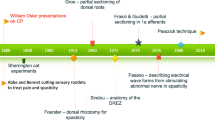Abstract.
We reviewed our 10-year experience of selective posterior rhizotomy (SPR), with an emphasis on surgical outcome concentrated on improvements in functional ability and adverse effects. We had performed SPR in 208 patients between 1990 and 1999. All patients showed an overall improvement (over 95%) in spasticity, passive range of motion, and gait pattern. Preoperative ambulatory functional level and age were very important predictive factors for further improvements in postoperative functional ability. Compared with the younger children, the older ones lacked a full range of motion preoperatively, and they continued to lack a full range of motion postoperatively, despite the decrease in tone achieved by SPR. Most postoperative complications such as hypotonia, urinary retention, spinal deformities, and sensory changes were temporary and not functionally important. We conclude that SPR is an effective method of alleviating spasticity and provides lasting functional benefits at acceptable complication levels in spastic children with cerebral palsy.
Similar content being viewed by others
Author information
Authors and Affiliations
Additional information
Electronic Publication
Rights and permissions
About this article
Cite this article
Kim, DS., Choi, JU., Yang, KH. et al. Selective posterior rhizotomy in children with cerebral palsy: a 10-year experience. Child’s Nerv Syst 17, 556–562 (2001). https://doi.org/10.1007/s003810100465
Received:
Revised:
Published:
Issue Date:
DOI: https://doi.org/10.1007/s003810100465




